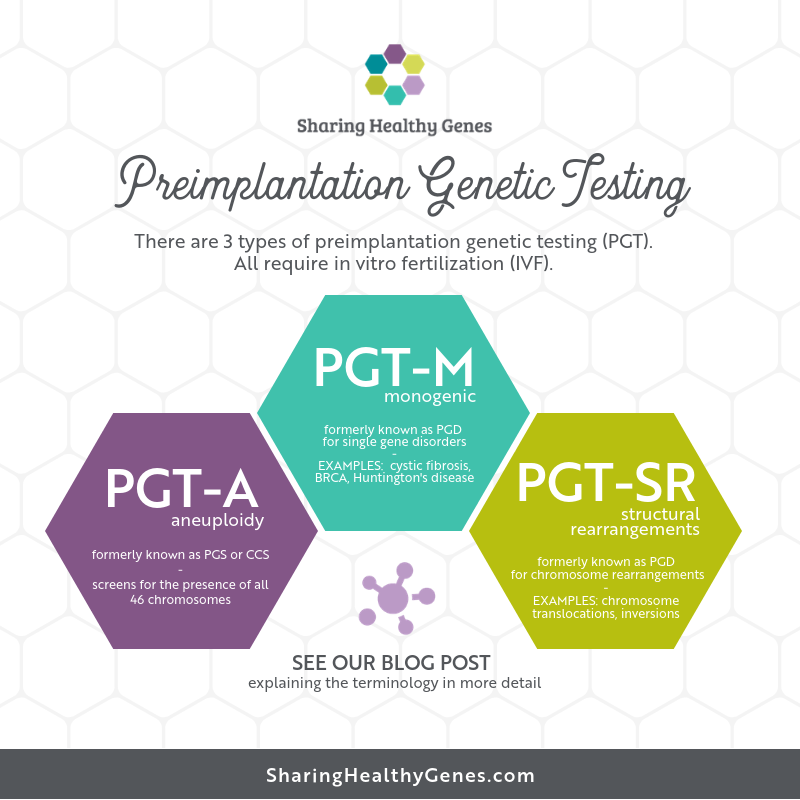When I first began working in the fertility sphere, I felt like I was learning an entirely new language. Healthcare professionals and patients involved in fertility evaluations and treatments have to wrap their minds around a bevy of unusual words, complicated medical terms, and more acronyms than you can count on both hands.
To complicate matters further, medical terminology and the corresponding acronyms used in fertility centers can change over time. We have witnessed this with the evolution of the term used to describe screening embryos for chromosome abnormalities and genetic diseases. This process may be referred to by many different terms including preimplantation genetic screening (PGS), preimplantation genetic diagnosis (PGD), comprehensive chromosome screening (CCS), and preimplantation genetic testing (PGT). It can be difficult to keep these terms straight, and in fact, many of these describe essentially the same process.
Using different terminology can cause confusion among healthcare professionals and patients. In an effort to improve consistency and communication between fertility professionals, researchers and patients, a standardized glossary of 283 fertility-related terms, and their definitions, was published in 2017.1 This glossary was developed by five working groups and 20 international participating organizations, including the American Society for Reproductive Medicine, the European Society of Human Reproduction and Embryology, and the March of Dimes.
One of the major terminology changes was a recommendation to replace the terms PGD and PGS with the umbrella term of “preimplantation genetic testing”, or PGT. PGT now encompasses all types of genetic testing on embryos.
ORM has traditionally used the term “CCS” to describe screening embryos for chromosome abnormalities and “PGD” to describe screening embryos for single gene disorders. In accordance with recent recommendations, however, we will be shifting our terminology and using the term PGT to describe all types of genetic testing on embryos. It is important to note that the way the embryos are tested is not changing, merely the words we use to describe the test.
To differentiate the specific types of embryo testing, PGT is divided into three subtypes, defined as:
- “PGT for aneuploidies” or PGT-A
PGT-A will now be used to describe screening embryos for sporadic chromosome abnormalities, instead of PGS and CCS. PGT-A refers to testing embryos by counting the 46 chromosomes to look for extra or missing chromosomes (“aneuploidy”). PGT-A is used to select embryos that are the most likely to implant and result in a successful pregnancy. It also reduces the chance of having a child with extra or missing chromosomes, such as Down syndrome.
- “PGT for monogenic/single gene disorders” or PGT-M
PGT-M will now be used to describe single-gene PGD. PGT-M is used to help individuals or couples reduce their risk to have a child with a known inherited disorder caused by mutations in a single gene (“monogenic”), such as cystic fibrosis or Huntington’s disease.
- “PGT for chromosome structural rearrangements” or PGT-SR.
PGT-SR will now be used to describe chromosomal PGD. This is different from PGT-A, as in these cases the chromosome abnormalities are hereditary due to one or both parents having a balanced chromosome “structural rearrangement” (such as translocations or inversions). PGT-SR reduces the risk of having a pregnancy or child with an unbalanced structural abnormality, which involves extra or missing genetic material and typically results in a pregnancy loss.
While ORM has shifted to using the term PGT, it will take some time for healthcare professionals in other specialties, policymakers, and the public to become aware of this new terminology. It may even take me a while to get used to things, given how many times I use the acronym CCS every day (a lot!). In the meantime, ORM’s genetic counselors are always available to provide further information or to answer any questions about CCS…I mean PGT-A… at geneticcounselor@ormfertility.com.
References: 1Zegers-Hochschild F, Adamson GD, Dyer S, et al. The International Glossary on Infertility and Fertility Care, 2017. Human Reproduction (Oxford, England). 2017;32(9):1786-1801. doi:10.1093/humrep/dex234.

